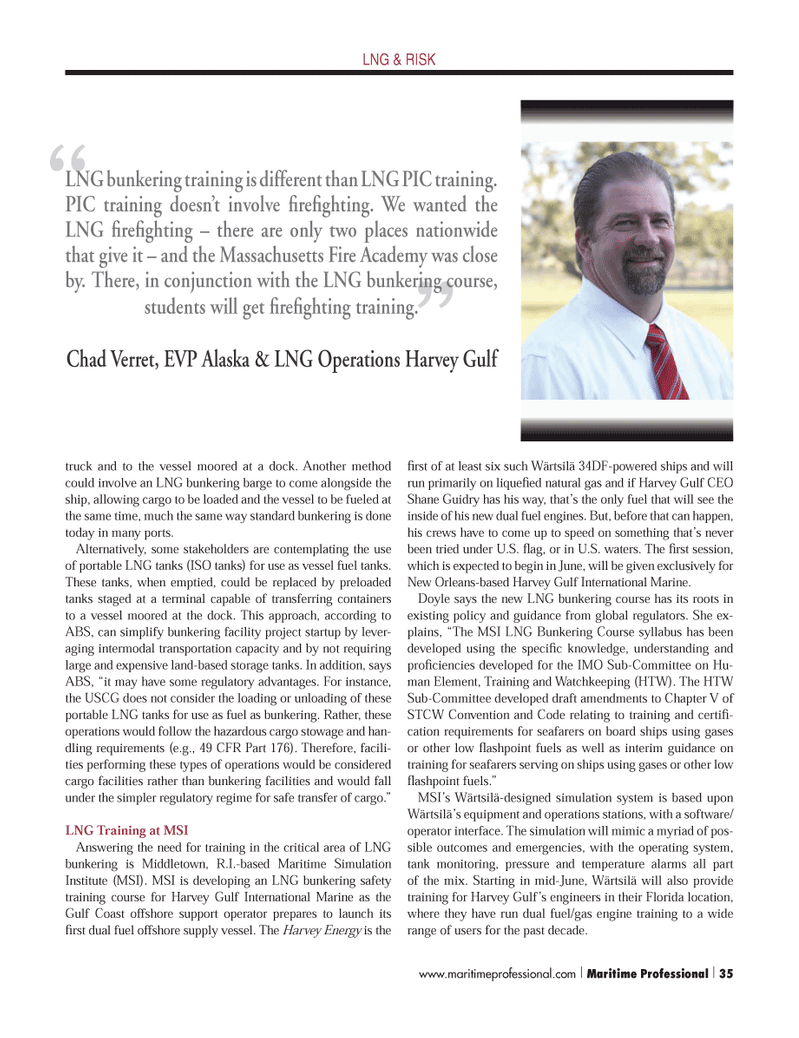
Page 35: of Maritime Logistics Professional Magazine (Q2 2014)
Maritime Risk & Shipping Finance
Read this page in Pdf, Flash or Html5 edition of Q2 2014 Maritime Logistics Professional Magazine
LNG & RISK ” “
LNG bunkering training is different than LNG PIC training.
PIC training doesn’t involve fi refi ghting. We wanted the
LNG fi refi ghting – there are only two places nationwide that give it – and the Massachusetts Fire Academy was close by. There, in conjunction with the LNG bunkering course, students will get fi refi ghting training.
Chad Verret, EVP Alaska & LNG Operations Harvey Gulf truck and to the vessel moored at a dock. Another method could involve an LNG bunkering barge to come alongside the ship, allowing cargo to be loaded and the vessel to be fueled at the same time, much the same way standard bunkering is done today in many ports.
Alternatively, some stakeholders are contemplating the use of portable LNG tanks (ISO tanks) for use as vessel fuel tanks.
These tanks, when emptied, could be replaced by preloaded tanks staged at a terminal capable of transferring containers to a vessel moored at the dock. This approach, according to
ABS, can simplify bunkering facility project startup by lever- aging intermodal transportation capacity and by not requiring large and expensive land-based storage tanks. In addition, says
ABS, “it may have some regulatory advantages. For instance, the USCG does not consider the loading or unloading of these portable LNG tanks for use as fuel as bunkering. Rather, these operations would follow the hazardous cargo stowage and han- dling requirements (e.g., 49 CFR Part 176). Therefore, facili- ties performing these types of operations would be considered cargo facilities rather than bunkering facilities and would fall under the simpler regulatory regime for safe transfer of cargo.”
LNG Training at MSI
Answering the need for training in the critical area of LNG bunkering is Middletown, R.I.-based Maritime Simulation
Institute (MSI). MSI is developing an LNG bunkering safety training course for Harvey Gulf International Marine as the
Gulf Coast offshore support operator prepares to launch its fi rst dual fuel offshore supply vessel. The Harvey Energy is the fi rst of at least six such Wärtsilä 34DF-powered ships and will run primarily on liquefi ed natural gas and if Harvey Gulf CEO
Shane Guidry has his way, that’s the only fuel that will see the inside of his new dual fuel engines. But, before that can happen, his crews have to come up to speed on something that’s never been tried under U.S. fl ag, or in U.S. waters. The fi rst session, which is expected to begin in June, will be given exclusively for
New Orleans-based Harvey Gulf International Marine.
Doyle says the new LNG bunkering course has its roots in existing policy and guidance from global regulators. She ex- plains, “The MSI LNG Bunkering Course syllabus has been developed using the specifi c knowledge, understanding and profi ciencies developed for the IMO Sub-Committee on Hu- man Element, Training and Watchkeeping (HTW). The HTW
Sub-Committee developed draft amendments to Chapter V of
STCW Convention and Code relating to training and certifi - cation requirements for seafarers on board ships using gases or other low fl ashpoint fuels as well as interim guidance on training for seafarers serving on ships using gases or other low fl ashpoint fuels.”
MSI’s Wärtsilä-designed simulation system is based upon
Wärtsilä’s equipment and operations stations, with a software/ operator interface. The simulation will mimic a myriad of pos- sible outcomes and emergencies, with the operating system, tank monitoring, pressure and temperature alarms all part of the mix. Starting in mid-June, Wärtsilä will also provide training for Harvey Gulf’s engineers in their Florida location, where they have run dual fuel/gas engine training to a wide range of users for the past decade. www.maritimeprofessional.com | Maritime Professional | 35 34-49 Q2 MP2014.indd 35 5/16/2014 2:55:49 PM

 34
34

 36
36
